Music and Sound Production Tools
Software Capabilities
With literally thousands of features in many modern music programs, how do you decide which software will help you be more creative and productive? There are no easy answers. Since current software offerings tend to blur the boundaries by including features from various categories, you may indeed be able to find one program that will do everything you need. In such a case, you can choose a tool based less on what it does than on how its user interface looks and feels to you. This is largely a subjective matter, however, so instead of getting sidetracked into the " knobs vs. sliders" debate, let's look at the basic capabilities found (in one form or another) in many commercially available music programs.
Multitrack recording/editing
Multitracking is the recording and editing of multiple simultaneous audio signals. Before digital audio software, you needed multitrack analog tape decks and eventually digital decks for multitracking. Now, multitrack features are found not only in "studio" software as you'd expect, but many other creative music and sound applications as well ( Figure 2.10 ).
Figure 2.10. Traditional mixer view in Adobe Audition.
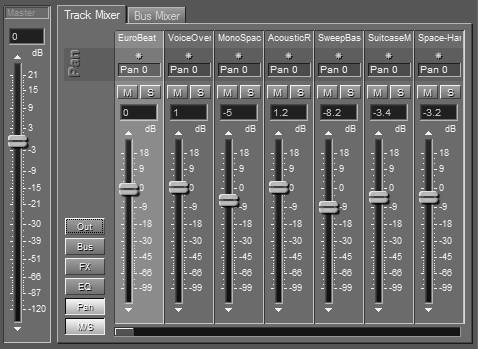
Specialized multitrack recording/editing applications include: BIAS Deck (Mac) Adobe Audition (Windows) (See the next section, "Sequencing")
Find out how to do it:
Chapters 5, 10
Specialized sequencing applications include: Digidesign Pro Tools Steinberg Cubase SX Mackie Tracktion Ableton Live Apple Logic (Mac) Cakewalk SONAR (PC) Rosegarden (Linux/Mac)
Find out how to do it:
Chapters 5, 8, 10
Sequencing
Sequencing is the construction of songs from MIDI, audio, and mix automation data. It's separated here from multitracking because it involves more than just audio.
The term is somewhat misleading because of its history: it's a throwback to vintage analog equipment, which constructed simple patterns out of sequences of voltages. (Does this sound like a tough way to make music? It was!) Sequencing later came to mean, in more general terms, arranging sounds and musical information into songs or mixes , first for MIDI alone and eventually for both MIDI and audio.
A sequencer now means any program with MIDI and audio recording, editing, and arranging functions ( Figure 2.11 ), including programs like Cubase, Logic, SONAR, and Digital Performer. These programs are often called digital audio workstations , but products in that category include many functions besides sequencing, including those found in the next few sections.
Figure 2.11. Typical sequencing interface with MIDI and audio, here in Cubase SX.
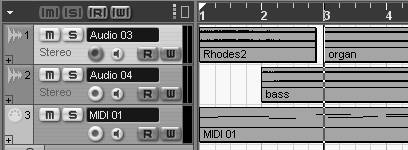
Waveform editing
Waveform editing , also called sample editing , involves detailed modifications to individual sound files. This can include the ability to edit sound at the level of the individual sample, as well as using other general tools for audio manipulation and batch processing. A waveform editor is to a multitrack editor as a text editor is to a page layout program. Most audio programs provide some kind of waveform editing, whereas others are dedicated entirely to the task ( Figure 2.12 ).
Figure 2.12. Waveform editing in Sony Sonic Foundry.
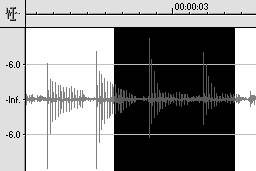
Specialized waveform-editing applications include:
Audacity
Sony Sound Forge (Windows)
Adobe Audition (Windows)
BIAS Peak (Mac)
Find out how to do it:
Chapter 10
Pattern-based editing
Pattern-based editing, sometimes called beat-based editing , mimics the limitations of primitive drum machines and constructs musical patterns for drums and instruments out of regular metrical patterns ( Figure 2.13 ). This approach naturally appeals to people producing dance music, but because it's simple, easy, and quick, it's useful for sketching quick drum patterns or basslines for other musical genres as well. Since pattern-based features were common on early synthesizers and drum machines, many software instruments include some kind of pattern-based editing. It's also found throughout certain specialized workstation apps.
Figure 2.13. A drum machine-style pattern editor in FL Studio.
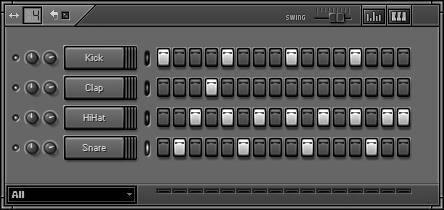
Specialized pattern-based editing applications include:
FL Studio (Windows)
Cakewalk Kinetic (Windows)
Propellerhead Reason
Find out how to do it:
Chapters 5, 8
Looping
Pattern-based editing uses loops of musical material, usually in the form of MIDI. Looping refers to tools that loop audio. These applications can modify the tempo and sometimes beat positions of audio samples without changing pitch. Programs like GarageBand and ACID can take advantage of special loop libraries containing hundreds of sampled grooves and instrumental materials. Again, they're indispensable for dance music, but can be used in any musical genre to sketch ideas, create backing tracks, or produce entire songs ( Figure 2.14 ).
Figure 2.14. Quick song construction with loops in GarageBand.

Specialized looping applications include:
Ableton Live
Sony Music ACID (Windows)
Apple GarageBand, Soundtrack, Logic (Mac)
Find out how to do it:
Chapters 5, 10
Synthesis (instruments)
You can produce an entire mix without ever recording a note. Synthesis is the creation of sound entirely in the digital domain. Synthesis techniques range from emulations of vintage equipment, like Arturia's painstaking re-creation of the original Moog Modular, to cutting-edge sound creation techniques only possible on the computer, like Apple's Sculpture in Logic Pro.
Specialized synth applications include:
Native Instruments Reaktor,
Absynth (synthesis), B4, FM7 (virtual instrument)
Arturia Storm (synthesis)
and vintage synth products Tascam GigaStudio (sample playback)
IK Multimedia SampleTank, Studiophonik (sample playback)
Find out how to do it:
Chapter 9
All software instruments involve some kind of synthesis, but sometimes the term virtual instrument is used to specifically refer to emulations of real-world, nonelectronic instruments ( Figure 2.15 ).
Figure 2.15. Native Instruments' B4 virtual instrument, an emulation of the Hammond organ.
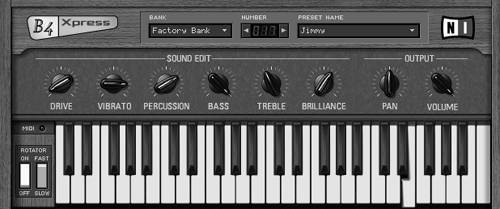
Signal processing (effects)
A digital effect is anything that takes an audio signal and changes it in some way, for example, reverbs , acoustic space simulators, delays, mastering, EQ, compression, sound-munchers, weird spacey sound warpers, and whatever else you can imagine. Signal processing is simply the use of effects. As the name implies, it's the processing of a signal.
Specialized signal-processing applications include:
TC Electronics Native Bundle
Waves Renaissance Maxx
Bundle Sony
Oxford Collection
Find out how to do it:
Chapter 7
Figure 2.16. Signal processing in MOTU's MasterWorks EQ, included with Digital Performer.
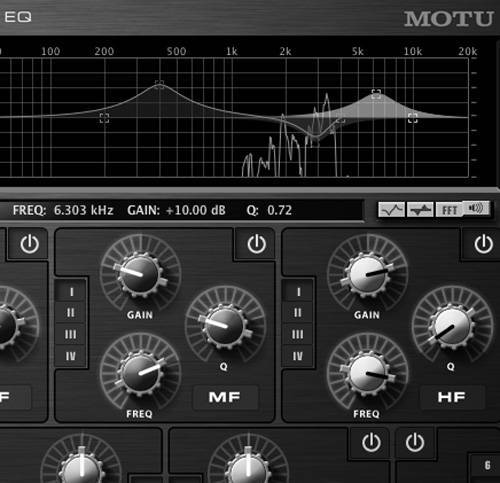
Guitar processing
Although it's technically just another form of digital effect, guitar processing deserves special mention. With the aid of software- modeled amplifiers , effects, and speaker cabinet simulation, software guitar processing can do what would otherwise require a lot of external equipment.
Specialized guitar-processing applications include:
Native Instruments Guitar Rig
IK Multimedia AmpliTube
Find out how to do it:
Chapter 13
Figure 2.17. GuitarRig simulates a rack of guitar amplifiers and effects.
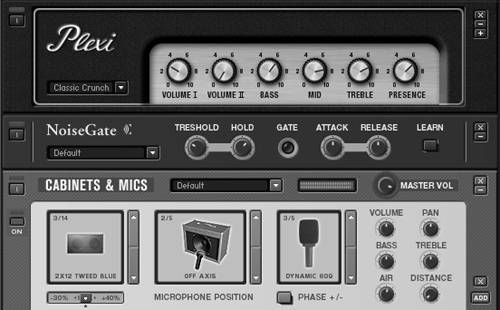
Mastering
Mastering is a general category of tasks related to preparing music and sound for distribution. It includes effects intended to smooth, sweeten, and balance the sound's dynamic and frequency range, and the process of exporting for broadcast, CD distribution, or Web sharing for a single song or a group of songs (as in an album).
Specialized mastering applications include:
Apple WaveBurner (Mac; included with Logic Pro)
Steinberg WaveLab (PC)
iZotope Ozone (Mac/PC plug-in)
IK Multimedia T-racks (Mac/PC plug-in)
Find out how to do it:
Chapter 10
Figure 2.18. You can prepare audio via effects and author a CD in Apple's WaveBurner mastering tool.
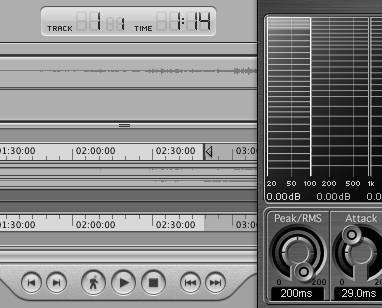
DJing
DJs have special requirements, like the ability to manage large libraries of music, cue music by prelistening to it before the crowd in a club hears it, adjust tempo and pitch, and cross-fade between audio signals. Because these same features can be useful to non-DJs as well, general-use applications like Ableton Live have become more appealing to DJs and non-DJs alike.
Specialized DJing applications include:
Native Instruments Traktor
Ableton Live
MegaSeg (Mac)
Find out how to do it:
Chapter 13
Figure 2.19. Use your mouse to cue, scratch, and cross-fade with the free Tactile 12000 (www.tactile12000.com).
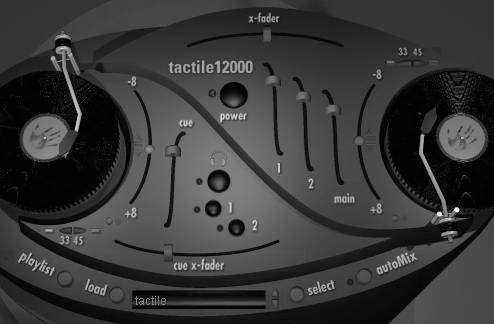
Notation
Music notation or scorewriting is the production of printed scores readable by musicians . Music notation usually interfaces with MIDI data, since it's a convenient standard for storing musical information. Although notation features in programs like Logic and Cubase are useful for quick song scores, composers and arrangers require various specific additional features depending on the complexity of their music and the technical requirements of musicians and publishers.
Specialized notation applications include:
Sibelius
MakeMusic Finale
Find out how to do it:
Chapter 11
Figure 2.20. Preparing guitar notation in Sibelius' G7.
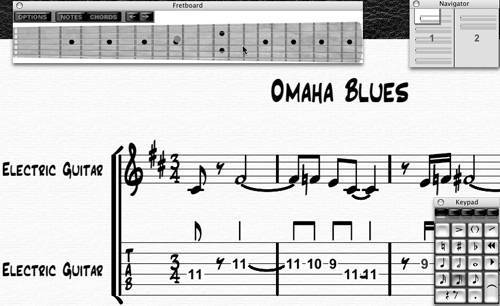
Modular and interactive control
Early synthesizers produced sound by connecting individual components , or modules , with patch cords. The approach was time-consuming but infinitely flexible because each module had just one task, and following the path of a signal was as easy as following the associated cable. Modern digital audio software adapts this method to allow the creation of custom sound and MIDI processing configurations, and interactive control that lets software respond to and control everything from MIDI to audio to live video signals.
Specialized modular and interactive applications include:
Native Instruments Reaktor
Cycling '74 Max/MSP
Pure Data
Find out how to do it:
Chapter 13
Figure 2.21. Behind Reaktor's interactive instruments is a modifiable, modular structure so you can create any sound, effect, or interactive instrument you can imagine.
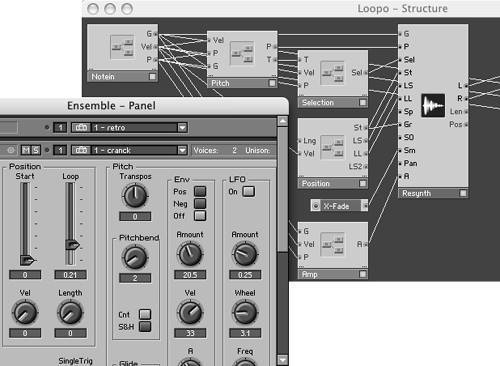
Specialized tools
Some applications have specific functions for certain markets. These functions aren't included in general-purpose audio workstations yet, but if they're critical to the work you do, you'll want to check them out:
-
Music learning utilities help students and musicians study music theory, musicianship, and composition.
-
Music accompaniment applications create automatic backing tracks to help musicians practice.
-
VJ/Video software creates interactive, real-time imagery, and is growing in popularity in clubs, art galleries, and onstage.
Building a Software Studio
One of the advantages of software audio production is that it affords nearly infinite flexibility. Since no two users are the same, no two software setups have to be the same. There are two primary approaches: buy an integrated workstation that does everything you need or assemble just the tools, instruments, and effects you need a la carte. Thanks to plug-in technology and other means of integrating software, there's a broad middle ground as well.
Integrated workstations
A Digital Audio Workstation (DAW) combines a variety of features and work methods into a single application. A DAW is defined by the ability to start, develop, and finish music and sound production within a single application. It can include some or all of the features mentioned earlier:
-
Audio features: Audio recording, waveform editing, mastering features, and file conversion/export
-
Sequencing features: Editing of MIDI and audio via traditional mixing interfaces, pattern-based editing, looping, or some combination of all three
-
Effects and instruments: A complement of included effects and instruments and/or support for third-party plug-ins
-
Additional extras: Many include guitar processing, notation, video/scoring features, or even basic modular and interactive functions for combining components
A number of applications fit into this general definition of a DAW:
-
Digidesign Pro Tools refers to both hardware and software, but the Pro Tools application itself is a definitive DAW. It's in a league of its own for its dominance in pro studios , although competitors have made some inroads in recent years . The primary difference between Pro Tools and other software is that Pro Tools requires Digidesign hardware in order to operate .
-
"Big Four" DAWs: Steinberg Cubase (now with pro sibling Nuendo), Cakewalk SONAR, MOTU Digital Performer, and Apple Logic ( Figure 2.22 ) all began as MIDI sequencers nearly 20 years ago. As Pro Tools added MIDI capabilities, these four DAWs added audio, and upgrade-for-upgrade each app has tried to top the other with sprawling feature lists.
Figure 2.22. Apple's Logic Pro is a good example of a single software workstation that does almost everything. It combines features like (1) traditional mixing via a channel strip interface, (2) detailed editing of MIDI and audio data, (3) included instruments and effects like the Sculpture physical-modeling synth, and (4) a notation view for editing and printing scores.
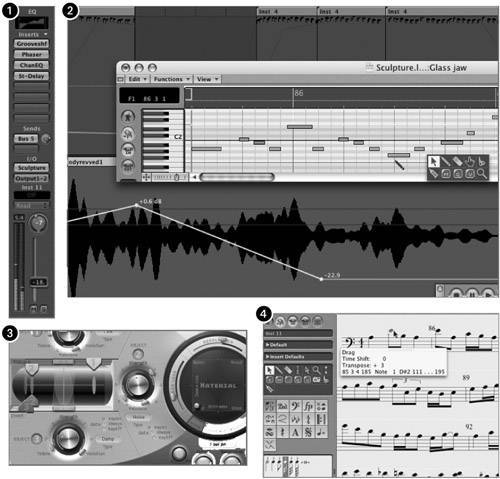
-
The New-Wave DAWs: The all-in-one approach of Pro Tools and the Big Four can sometimes overwhelm creative music production, so a new generation of applications has focused on simplified interfaces and streamlined workflows. Not everyone would consider Tracktion, ACID, Live, Reason, FL Studio, or even GarageBand a DAW, but that hasn't stopped devoted users from adopting them for studio production and performance. Many users combine these tools with more traditional DAWs to take advantage of the strengths of each.
Naturally, it can be difficult to distinguish the differences between applications with deep, overlapping feature sets. The choice is entirely personal: If you visit the studio of any top musician or producer, you'll likely find a wide variety of these applications in use.
|
| | Music learning: Sibelius Educational Suite (www.sibelius.com) ECS Media (www.ecsmedia.com) Music accompaniment: MakeMusic SmartMusic (www.smartmusic.com) PG Music Band-in-a-Box (www.pgmusic.com) Soundtrek Jammer (www.soundtrek.com) VJ/Video software: Isadora (Mac, PC) (www.troikatronix.com) motion dive.tokyo (www.digitalstage.net) Vidvox VDMX and GRID (www.vidvox.net) Cycling '74 Jitter (www.cycling74.com) |
Combine software for a custom studio
Developers have devised ways of combining applications, allowing you to build a studio from a combination of software. Audio software fits into one of three categories:
| | To learn more: See Chapter 4 for more on configuring your system and Chapter 7 for how to use these plug-ins in your mix. |
-
Host: A single application, usually your DAW, that provides access to your interface, mixing, and arrangement capabilities, and hosts additional plug-in effects and instruments as well as client applications ( Figure 2.24 ).
Figure 2.24. Starting with a host like Mackie's Tracktion shown here, you can add capabilities via commercial, shareware, and freeware plug-ins, such as this donationware phaser effect from www.smartelectronix.com.
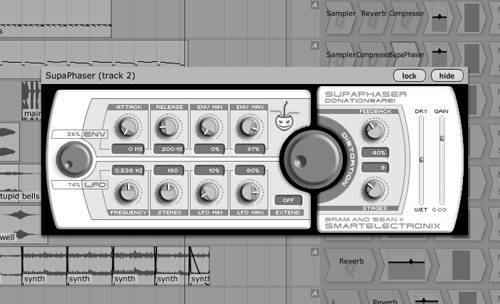
-
Plug-in: A piece of software that runs only inside a host environment.
-
Stand-alone: A separate application that runs on its own. To use a stand-alone app with a host, you'll need a technology like ReWire to route audio and MIDI data between them. Or if the software doesn't support ReWire, system-level technologies like Jack will work with all applications.
Using a combination of software from these three categories, there are an almost infinite number of possible software setups thanks to common open formats ( Table 2.8 ). As long as you have a host of some kind, whether it's a simple freeware/shareware host or a full-fledged workstation, you can add a la carte instruments, effects, and other tools at will. Even without running a host, you can run a stand-alone application whenever you need it.
Table 2.8. Plug-ins and Audio/MIDI Routing Platforms
| Platform | Plug-in Support | MIDI and Audio Between Supported Applications | Audio Between Any Applications |
|---|---|---|---|
| Windows | VST, DX | ReWire | N/A |
| Mac OS X | VST, AU | ReWire, Core Audio's Inter Application Communications (IAC) | Jack OS X |
| Linux | VST, LADSPA | None currently available | Jack |
| Digidesign systems (Mac/Win) | RTAS, TDM | ReWire | N/A |
The only caveat is that plug-ins must be written to take advantage of a host environment via one of a number of standards: open formats used by multiple applications (VST, DX, AU, and LADSPA); proprietary formats for specific compatibility with a product, like Digidesign's RTAS and TDM; or other host- or hardware-specific formats. Since not all applications support all formats, you may need to use wrapper programs from companies like FXpansion (www.fxpansion.com) to extend compatibility.
Adding Hardware to Your Studio
Many novice users build their initial studio using software to save space and money. That doesn't mean, however, that hardware isn't worth a look for many of the same tasks software performs . Hardware has a number of potential advantages:
-
Tactile, physical control (particularly indispensable with musical instruments)
-
Reliability and durability
-
Zero-latency responsiveness and instant-on gratification
-
Distinctive sounds not possible with software
In short, hardware is fun to use, and there's no reason it can't be integrated into a computer studio. You can generally control external digital hardware via MIDI and synchronization controls or the more advanced of tools like Apple Logic's Environments. You don't need computer control of everythingoften simple audio routing will work wellbut see the sidebar "Hardware-Software Connections Checklist" for some good questions to ask.
Products to consider include:
-
Instruments: Whether you're a guitarist, keyboardist, drummer , or looking for something different altogether, there's an instrument for you.
-
Effects devices: Process vocals and instruments before they reach the computer, or route audio out from your mix ( especially easy with a digital mixer).
-
Guitar amps: You can mic guitar amps directly instead of using software amplification.
-
Multitrack workstations: Portable models are perfect for road recording without lugging your computer, whereas other models can act as a replacement for computer DAWs.
-
Groove boxes and toys: Create beats for dance music using straightforward hardware controls, optionally coupled with a computer ( Figure 2.25 ).
Figure 2.25. You could perform the same functions as this Korg ElecTribe exclusively in software, but some users like the feel of physical hardware and the sense of creativity hardware interfaces give them.
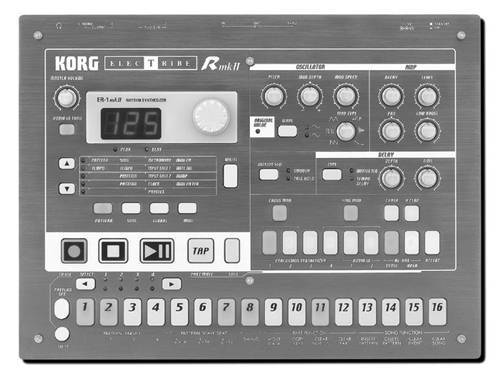
|
| | Major hardware manufacturers include: Korg , general equipment (www.korg.com) Roland , general equipment (www.roland.com) Yamaha , general equipment (www.yamaha.com) Alesis , general equipment (www.alesis.com) Tascam , recording (www.tascam.com) Samson , recording (www.samsontech.com) Stanton , turntables and DJ accessories (www.stantondj.com) Gibson , guitars and general equipment (www.gibson.com) Fender , guitars and general equipment (www.fender.com) |
